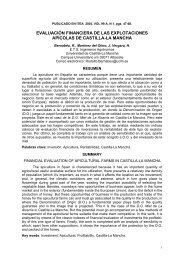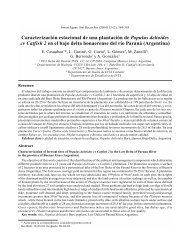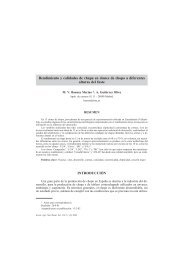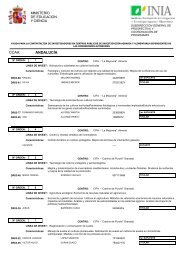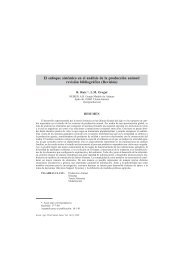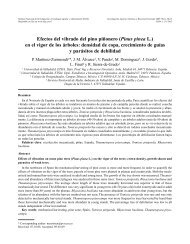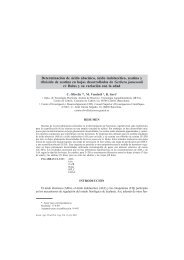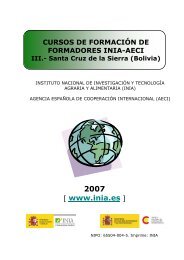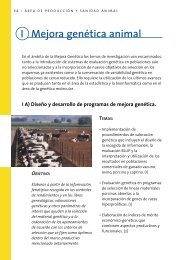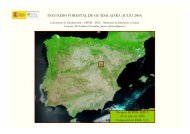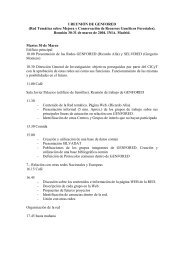Status of medicinal and aromatic plants in - Inia
Status of medicinal and aromatic plants in - Inia
Status of medicinal and aromatic plants in - Inia
Create successful ePaper yourself
Turn your PDF publications into a flip-book with our unique Google optimized e-Paper software.
PRESENTED PAPERS 85<br />
<strong>Status</strong> <strong>of</strong> <strong>medic<strong>in</strong>al</strong> <strong>and</strong> <strong>aromatic</strong> <strong>plants</strong> <strong>in</strong> Malta<br />
Everaldo Attard<br />
Institute <strong>of</strong> Agriculture, University <strong>of</strong> Malta, Msida, Malta<br />
Introduction<br />
Although the Maltese Archipelago has a restricted environment due to its small size, the<br />
diversity <strong>in</strong> biological species is vast. The variation <strong>in</strong> biodiversity is ma<strong>in</strong>ly l<strong>in</strong>ked to the<br />
connection <strong>of</strong> the warm North Africa to the cold southern Europe. The bioclimatic<br />
conditions <strong>of</strong> Malta are also found <strong>in</strong> coastal regions <strong>of</strong> other Mediterranean countries. In<br />
fact, about 66% <strong>of</strong> the flora <strong>of</strong> Malta is common to other Mediterranean regions. Common<br />
<strong>medic<strong>in</strong>al</strong> flora <strong>of</strong> the Mediterranean region <strong>and</strong> Malta <strong>in</strong>clude conifers (P<strong>in</strong>us halepensis <strong>and</strong><br />
Cupressus sempervirens), broadleaved trees (Laurus nobilis, Morus nigra, Tamarix gallica <strong>and</strong><br />
Rhus coriaria), fruit trees (Ceratonia siliqua, Ficus carica, Punica granatum, Cercis siliquastrum,<br />
Nerium ole<strong>and</strong>er, Citrus aurantium <strong>and</strong> Olea europea) <strong>and</strong> others (Allium sativum, Aloe ferox,<br />
Arbutus unedo, Capparis sp<strong>in</strong>osa, Myrtus communis, Opuntia ficus-<strong>in</strong>dica, Origanum vulgare,<br />
Papaver somniferum, Phytolacca dec<strong>and</strong>ra <strong>and</strong> Pistacia lentiscus). The other 34% <strong>of</strong> the flora is<br />
adapted to cold European conditions (Populus alba, Salix spp. <strong>and</strong> Crataegus monogyna) <strong>and</strong><br />
subtropical conditions (Ceratonia siliqua, Ficus carica, Myrtus communis <strong>and</strong> Cynomorium<br />
cocc<strong>in</strong>eum).<br />
There are about 1264 vascular plant species, <strong>in</strong>clud<strong>in</strong>g casual or naturalized aliens. Of<br />
these, 458 species possess <strong>medic<strong>in</strong>al</strong> value <strong>and</strong> have been used <strong>in</strong> traditional medic<strong>in</strong>e for<br />
several ailments (Lanfranco 1975, 1993) particularly related to the Mediterranean region.<br />
These refer to the nervous system (15%), gastro<strong>in</strong>test<strong>in</strong>al (24%), cardiovascular (14%),<br />
dermatological (13%) <strong>and</strong> antimicrobial (4%). Predom<strong>in</strong>at<strong>in</strong>g <strong>medic<strong>in</strong>al</strong> plant families<br />
<strong>in</strong>clude Compositae (15%), Labiatae (7%), Legum<strong>in</strong>osae (6%), Rosaceae (4%), Umbelliferae<br />
(4%), Liliaceae (3%), Solanaceae (3%), Cruciferae (3%), Caryophyllaceae (2%), Ranunculaceae<br />
(2%) <strong>and</strong> Papaveraceae (1%). These <strong>aromatic</strong> <strong>and</strong> <strong>medic<strong>in</strong>al</strong> herbs are found <strong>in</strong> small patches<br />
throughout the country (Haslam et al. 1977).<br />
Medic<strong>in</strong>al <strong>and</strong> <strong>aromatic</strong> plant status<br />
A considerable number <strong>of</strong> <strong>medic<strong>in</strong>al</strong> <strong>plants</strong> are under threat, ma<strong>in</strong>ly not due to overuse but<br />
to degradation by human activities <strong>in</strong>clud<strong>in</strong>g build<strong>in</strong>g <strong>and</strong> agricultural practices. Table 1<br />
shows the status <strong>of</strong> the threatened population <strong>of</strong> <strong>medic<strong>in</strong>al</strong> <strong>plants</strong> <strong>in</strong> relation to the local<br />
threatened plant species (Lanfranco 1989).<br />
Table 1. Medic<strong>in</strong>al <strong>plants</strong> under threat <strong>in</strong> Malta (adapted from Lanfranco 1989)<br />
Ext<strong>in</strong>ct Endangered Vulnerable Rare Indeterm<strong>in</strong>ate Total<br />
Medic<strong>in</strong>al <strong>plants</strong> 9 9 5 20 1 44<br />
Total species 109 74 44 137 34 398<br />
Ex situ conservation<br />
In Malta, few ex situ conservation measures are undertaken for <strong>medic<strong>in</strong>al</strong> <strong>plants</strong>. However,<br />
the Institute <strong>of</strong> Agriculture, University <strong>of</strong> Malta <strong>in</strong> collaboration with the Micropropagation<br />
Centre, Department <strong>of</strong> Plant Health, has looked <strong>in</strong>to conservation <strong>of</strong> <strong>medic<strong>in</strong>al</strong> <strong>plants</strong><br />
through micropropagation. Another area <strong>of</strong> <strong>in</strong>terest for <strong>medic<strong>in</strong>al</strong> <strong>plants</strong> is their yield <strong>of</strong><br />
secondary metabolites under <strong>in</strong> vitro <strong>and</strong> <strong>in</strong> situ conditions (Cassar 1998; Attard 2001). In the<br />
near future, the threatened species will be considered on an <strong>in</strong>dividual basis <strong>in</strong> order to<br />
regenerate their populations. The University Botanic Gardens <strong>and</strong> the Government's nursery




